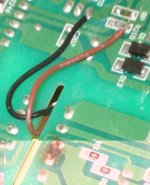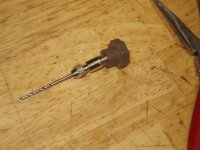One of the items donated to the Electricleâ„¢ project is a High-Power LiFePO4 charger for a 48V pack. HP8204L 16S, 58.4VDC 3A. Naturally, like most of the donated things, it's seen better days.
When I opened it up, I found a little burn mark on the bottom next to an obvious modification of the design, but one which appears to have been done at the factory. Two 2-watt-ish power resistors
View attachment 3
have been installed in place of a tiny little SMT part (which is no longer there, so can't tell what it was supposed to be), by:
--heatshrinking whatever these two resistors are (haven't cut the heatshrink to check yet),
--running wires from them thru the high-voltage isolation slot
--and soldering to pads on the bottom of the PCB somewhere on the secondary side.
Step 2 there is not a brilliant idea, for safety, and is what actually caused the failure, indirectly. One of those wires (neither of which was glued down) got pinched between one of the primary-side transformer pins and the clear plastic sheet that protects the bottom from shorting against the metal charger case. Over time it pushed thru the cheap insulation and POW ZAP KAZOWIE blew something up, dunno on which side of the tranformer yet.

I superglued the wires down in the areas near there with no traces, so this can't happen again. I did leave them running thru the isolation slot; if this all works maybe I'll fix that later.
3.5A mains fuse was blown, although since it was wrapped in heatshrink for unknown reasons (there is nothing it could short to even on the endplate) that wasnt' obvious till I started checking with a meter for such things. Since it was a pigtail fuse soldered in, I pulled some fuse holders off an old multifunction laser printer board to install, figuring I'll be popping a few fuses fixing this thing.

Seeing as the holders need two holes but there is only one at each pad for their pigtailed fuse, I had to drill two new holes. I have a handful of little drillbits just for this purpose, but I decided for some reason to hide from myself my Dremel, my hand drill, and my little jewelry screwdriver set that has swappable bits.

The probe tip was meant to have replaceable tips, so when they wore out you could put new ones in, and use different sizes for different purposes. But the crappy plastic handle/pencil part of the leads disintegrated long ago, and all I have left is the neat little collet it used. Which happens to have a hole exactly the same size as the drillbit I need to use. :lol:
Now I have a little finger drill I can make holes in the PCB in about a minute or less. Only took me a bit less time to make it than to type this up so far. Installed the fuse holders, and picked a couple of test fuses out of my bag of them salvaged from various power supplies over the years. No 3.5A, but a 2A; should be fine for testing with no load.
Checked some other basic parts for shorts or opens, and seemed ok, so powered it up. POOF. Bright flash inside the fuse glass, which is now totally black except for a little slag on the inside here and there.
I'll have to go back to it later when I can think better to retrace everything on the primary side and find whatever is shorting it so thoroughly. Something sure is, as bad as that fuse blew.

